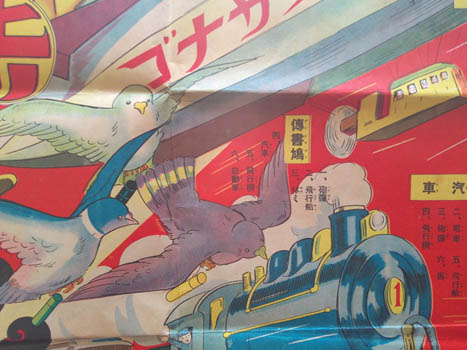
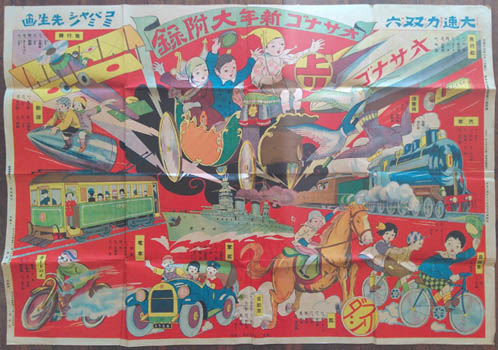
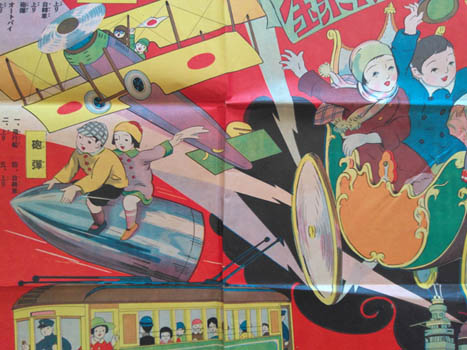
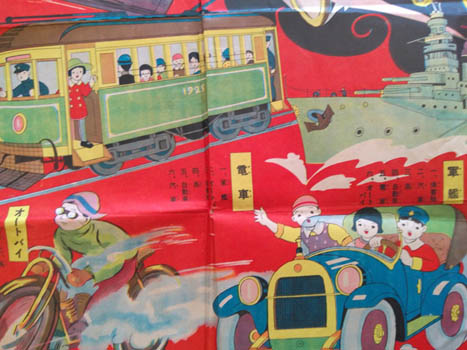

Kobayashi [Eijiro?] [Daisokuryoku Sugoroku]. Tokyo, Osanago 1926 (Taisho 15) Colour broadside 77x53cm. A bit of misfolding and a couple on tiny holes, pretty good. Au$350
Reckless speed for the smaller kids, this was the new year gift from the magazine Osanago. The girls ride pillion but they do get to go fast.
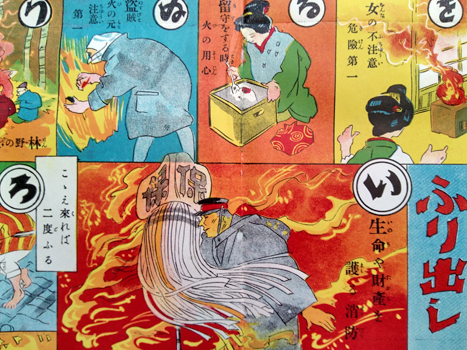
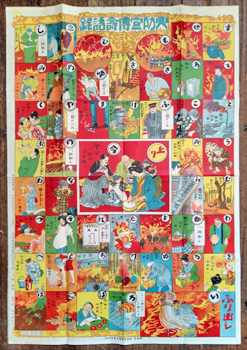
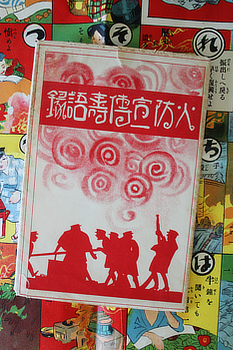
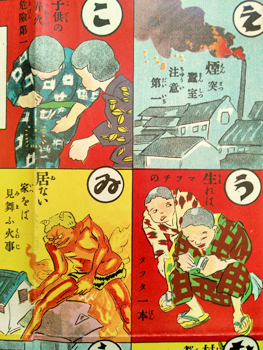

Fire sugoroku. [Hifuse Senden Kotobuki Goroku]. Nagano Prefecture, Hofukujimachi Shobo-gumi 1926 (Taisho 15). Colour broadside 80x55cm. A rather good copy with its original illustrated envelope. Au$650
A thrilling, vivid and rare game, bristling with peril and disaster, issued by the Hofukujimachi fire fighting department. I haven't found a record of another copy anywhere except here.
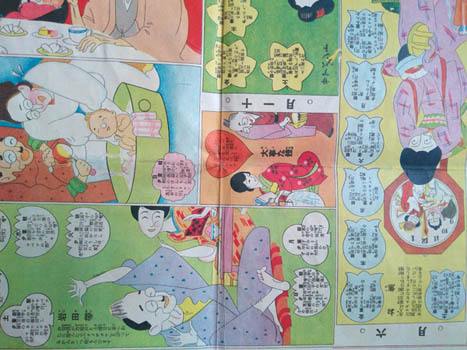
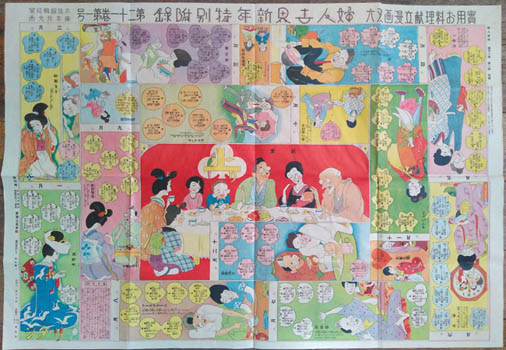
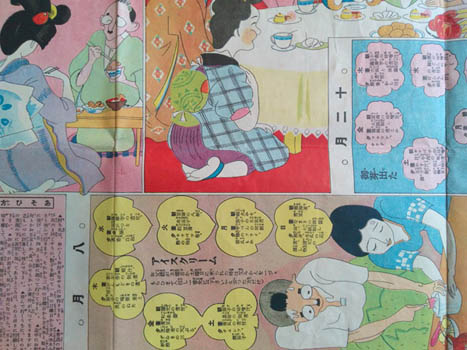
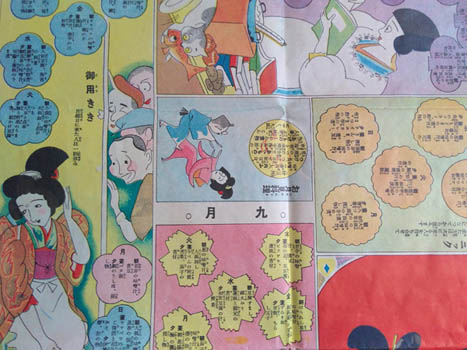

Fujimoto Katao. [Jitsuyo Oryori Kondate Manga Sugoroku]. Tokyo, Fujin Sekai 1926 (Taisho 15). Colour broadside 55x79cm. Mildly used, quite a good copy. Au$500
This delightful manga sugoroku celebrates cooking and was the new year gift from the magazine Woman's World.
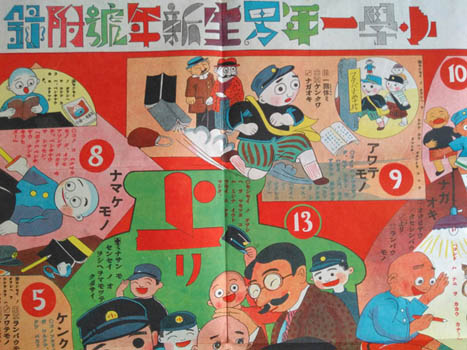
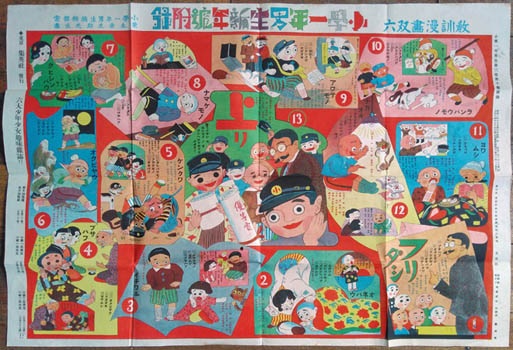
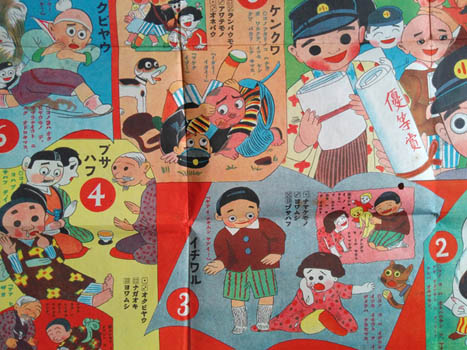
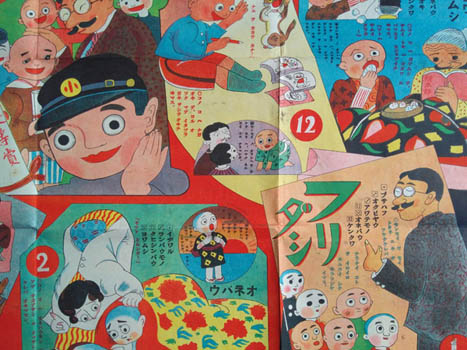

Kuriki Kojiro. [Kyokun Manga Sugoroku]. Tokyo, Shogaku 1927 (Showa 2). Colour broadside 54x78cm. Some splodges and a small hole, not a bad copy. Au$325
The new years gift from the boy's first grade magazine of the Shogaku stable. A bright sugoroku in which, as I see it, most of the fun is what we are warned against. The title was used for more than one sugoroku.
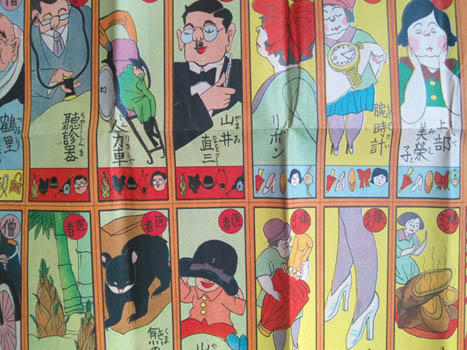
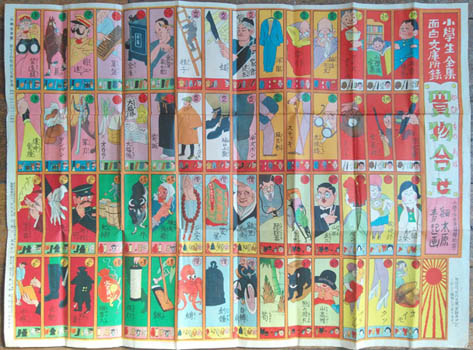
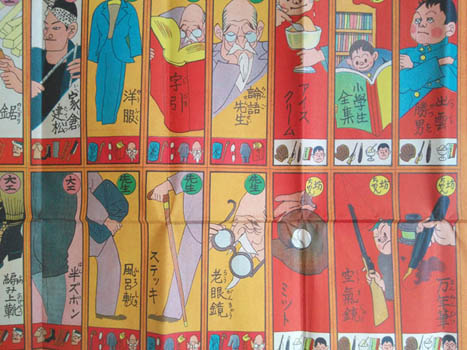
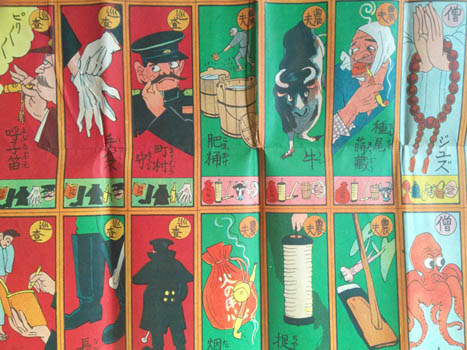

Hosokibara Seiki. [Kaimono Awase]. Tokyo, Kobunsha 1927 (Showa 2). Colour broadside 46x62cm. Mildly used and rumpled, pretty good. Au$300
Not a sugoroku, this fun manga sheet was made to be be cut up and played as a matching game. It was issued as a supplement to the series of books, Shogakusei Zenshu.
Hosokibara, as well as being a busy and successful manga artist, pioneered manga studies with his 1924 history and pioneered the schism among manga artists: those who saw manga as a continuation of traditional Japanese humorous drawings and those who rejected the notion and insisted that manga was a new international graphic language.
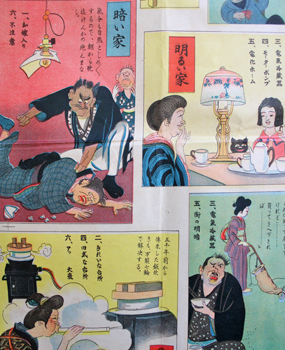
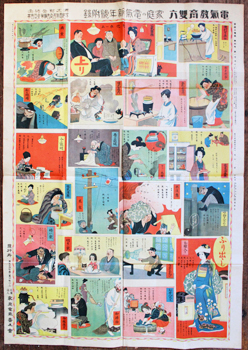
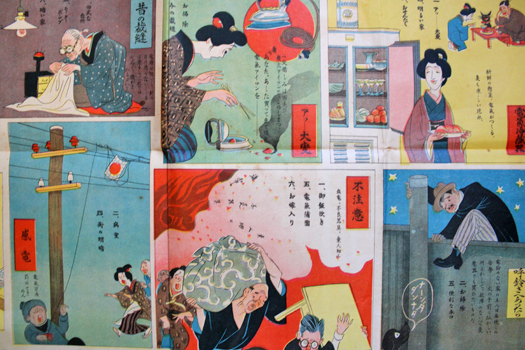
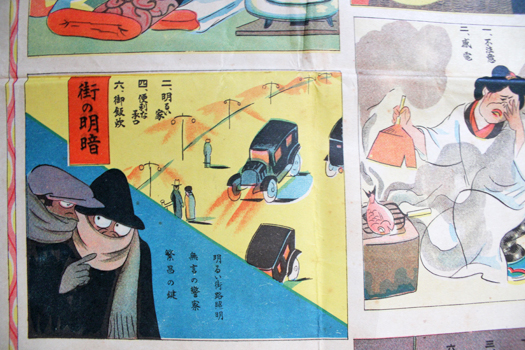

Shimizu Taigakubo. [Denki Kyoiku Sugoroku]. Tokyo, Katei no Denki 1927 (Taisho 16). Colour broadside 79x54cm. A touch browned, a pinhole in one fold; rather good. Au$600
This delightful and most uncommon game was the new year gift from the magazine Household Electricity. Many of the advantages of electricity are self evident but I discovered that a decently lit house cuts down on wife beating.
Taigakubo was, with Rakuten and Ippei, a founding member of the Tokyo Manga Association.
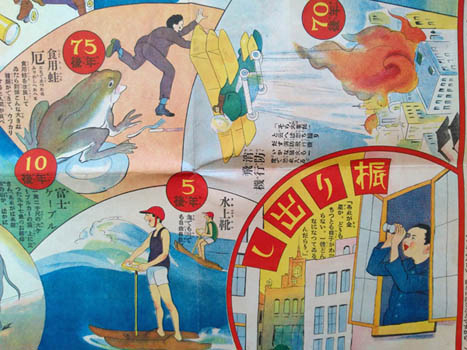
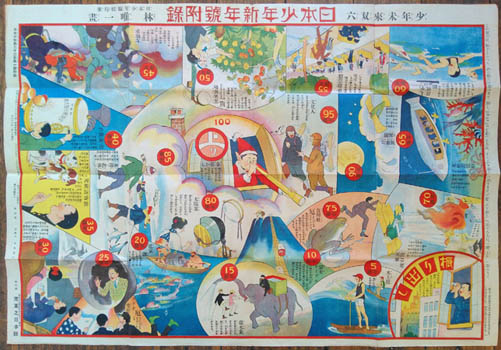
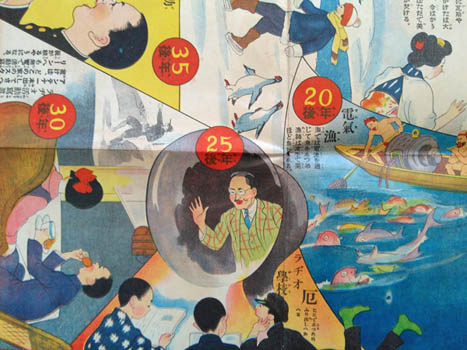
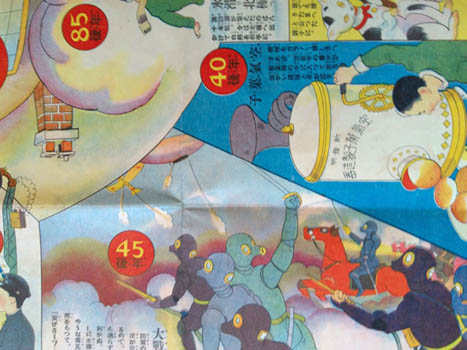

Hayashi Taidichi. [Shonen Mirai Sugoroku]. Tokyo, Nihon Shonen 1927 (Taisho 16). Colour broadside 54x79cm. Rather good. Au$450
This is a future to look forward to. Mostly. The gas warfare is not so inviting but at least the horses get protective suits. And it's only fair that giant edible frogs should have a chance to eat us. This was the new year gift from the magazine Nihon Shonen - Japanese Boy.
Hayashi redesigned Tokyo after the earthquake and fire - in 1924's new year sugoroku - to be a wonderful utopia for boys of all ages. Mostly there is no Taisho 16 but this was produced the year before, before the change in emperors.
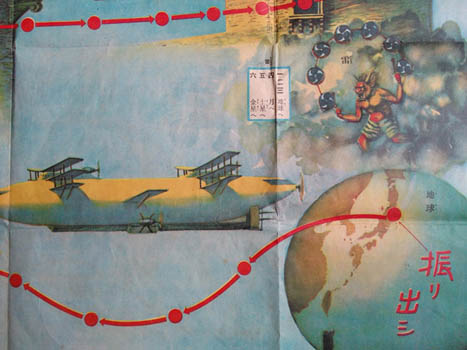
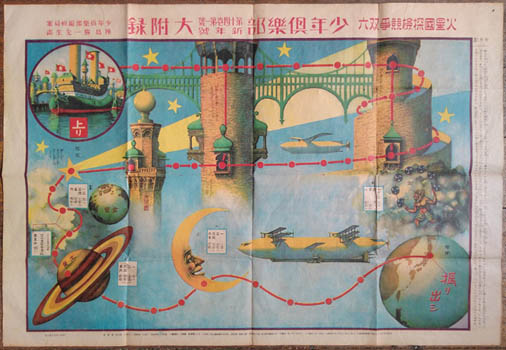
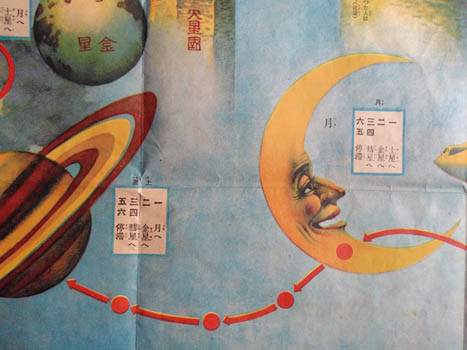
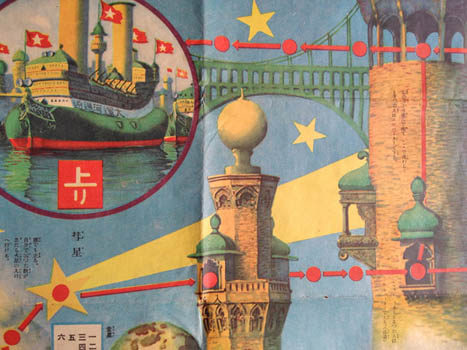

Kabashima Katsuichi. [Kasei Kuni Tanken Kyoso Sugoroku]. Tokyo, Shonen Kurabu 1927 (Taisho 16). Colour broadsheet; 79x54cm. On the back is another game in monochrome. Some browning a few small holes, pretty decent. Au$450
I proclaim this the masterpiece of Kabashima - a busy illustrator and cartoonist for a few decades. He may be best known as the creator of the comic or manga series starring Shochan - which looked a lot like Herge before Herge did - or perhaps as the artist of ships and planes in turmoil but this meandering voyage to Mars via Saturn tops them all.
This was the new year gift from the kids' magazine Shonen Kurabu (kids' club) and, being printed well in advance, is dated Taisho 16 rather than Showa 2 - the more proper date for 1927. The game on the back is the adventures of Yaji and Kita on the Tokaido. It's neither here nor there.
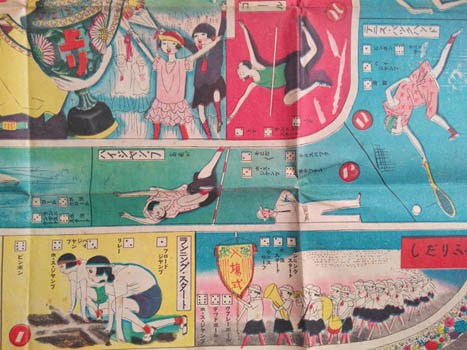
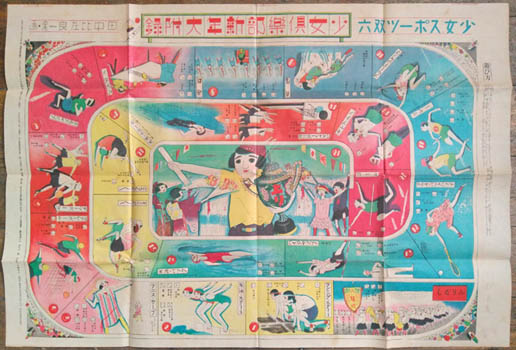
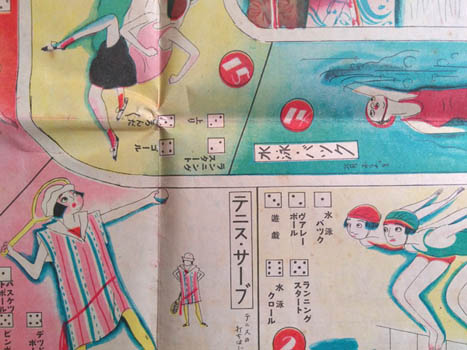
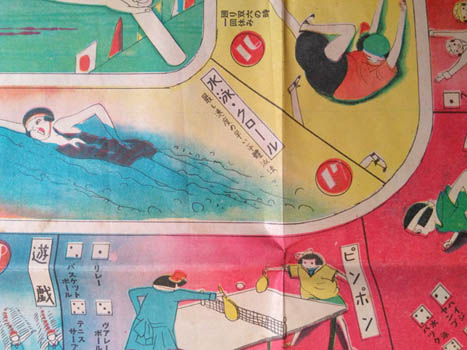

Tanaka Higara. [Shojo Supotsu Sugoroku]. Tokyo, Shojo Kurabu 1927 (Taisho 16). Colour broadsheet 54x79. A rather good copy. On the back are photographs and details of heroines of Japanese sport printed in blue. Au$425
Stylish indeed but not printed on the best paper, this sugoroku is hard to find still in one piece. This was the new year gift from the girl's magazine Shojo Kurabu - Girl's Club. There are not so many sugoroku in which girls get to be unashamedly athletic and competitive.
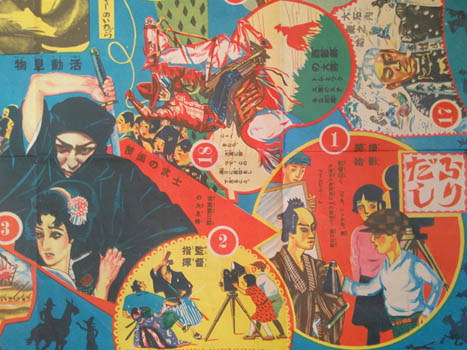
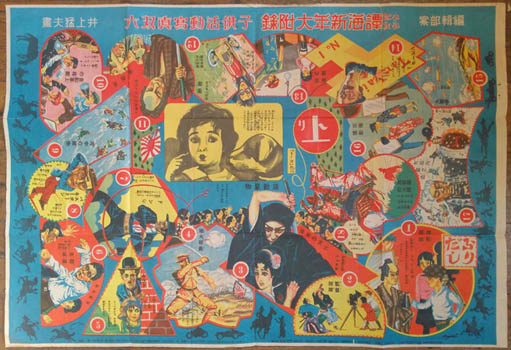
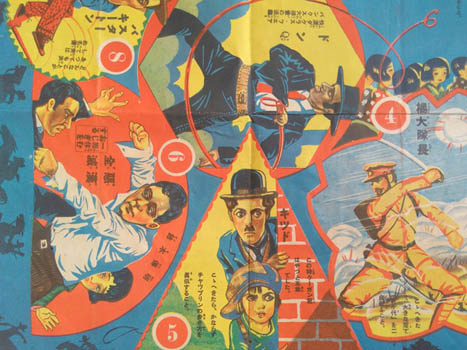


Inoue Takeo. [Kodomo Katsudo Shashin Sugoroku]. Tokyo Shonen/Shoji Tankai 1927 (Taisho 16). Colour broadsheet 53x79cm. Some small holes and repairs to folds, a reasonable copy. On the back is an unusally exciting monochrome game - the bonus games put on the back rarely amount to much - a shadow game of battling monsters illustrated by Nakano Shoji. Au$500
This cinematic new year gift is from both boys' and girls' magazines, Shonen Tankai and Shoji Tankai. In love of movies at least, boys and girls are equal. Also equal in this game are Hollywood and Japanese cinema - given that Shirley is queen of all. But. Come to making your own movie and the girl gets to operate the camera while the boy directs.
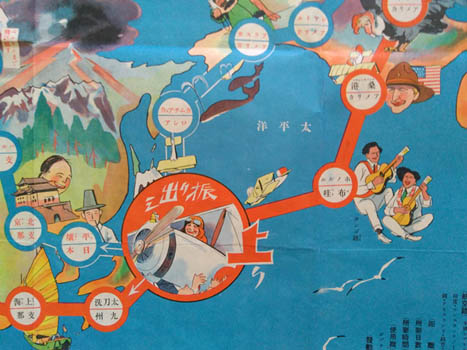
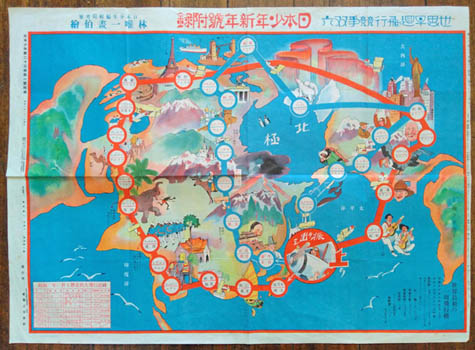
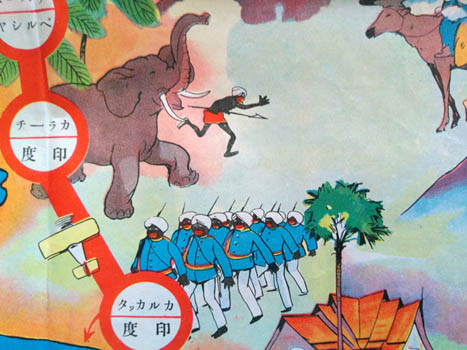
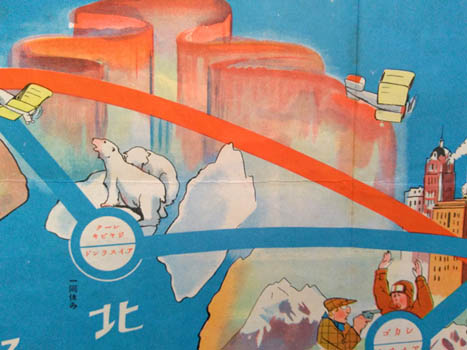

Hayashi Tadaishi. [Sekai Haya Mawari Hiko Kyoso Sugoroku]. Tokyo, Nihon Shonen 1928 (Showa 3). Colour broadsheet 55x76. On the back is another game - a warship battle seemingly taking place among coral atolls - printed in blue. Trimmed a bit close on one side. Au$375
A flying race around the world - so the title tells us - maybe, if you consider the northern hemisphere the whole world. This was the new year gift from the boys' magazine Nihon Shonen.
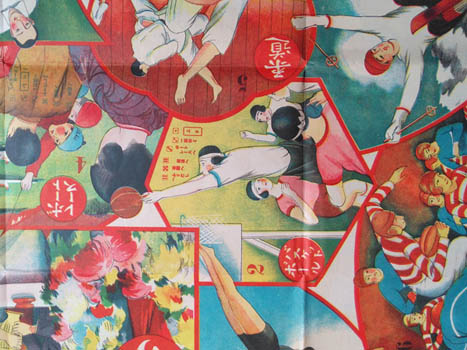
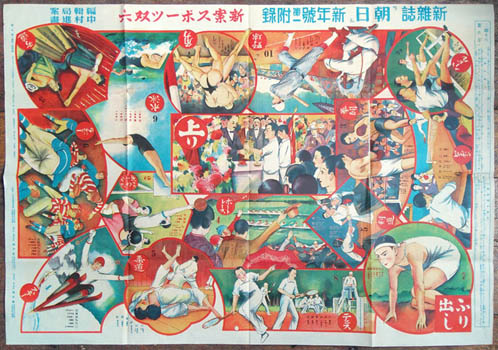
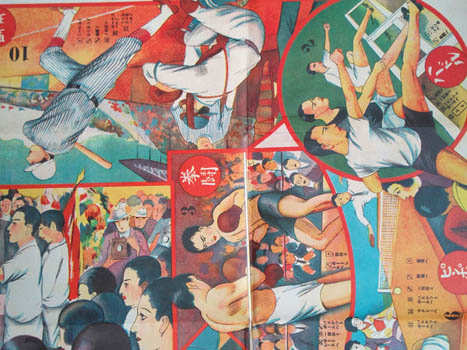
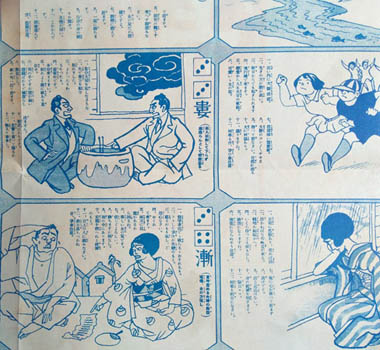

Nakamura Susumu [&] Hosokibara Seiki [&] [Shin'an Supotsu Sugoroku [&] Unmei Unsei Dokusen-ban]. Tokyo, Asahi 1929 (Showa 4). Broadsheet 54x79cm, colour game on one side, game printed in blue on the other. Quite good. Au$300
1929's new year gift from Asahi is a stylish if fun-free game of sports. No smiles here, winning is a serious business. What I learn from this is that if you want to meet girls then table tennis is the game. Nowhere else are they in sight. The game on the back is outwardly much plainer but it is fun; there are a lot of pretty good drawings and cartoons by Hosokibara Seiki.
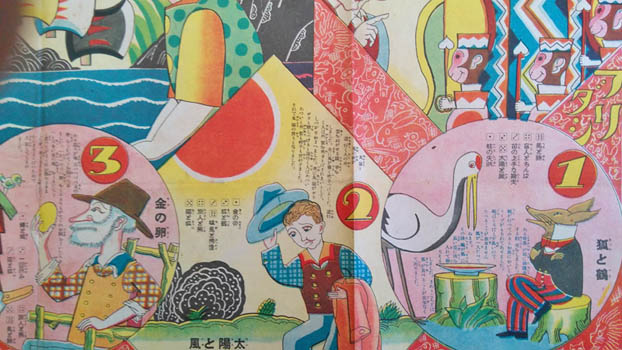
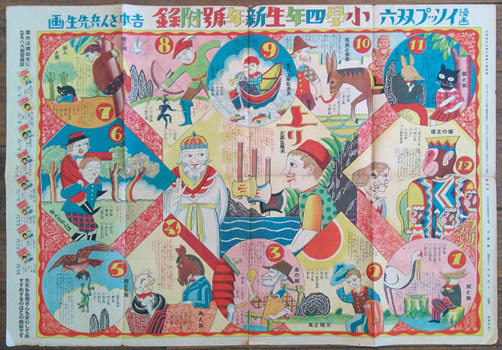
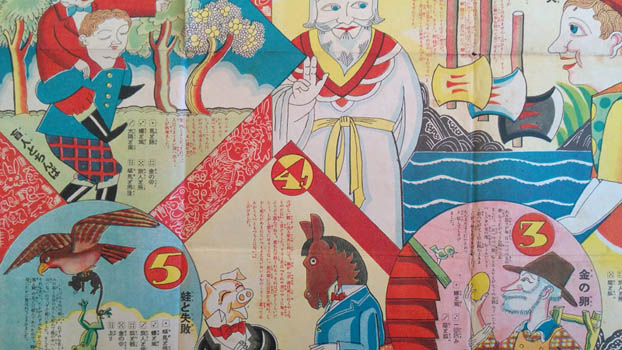
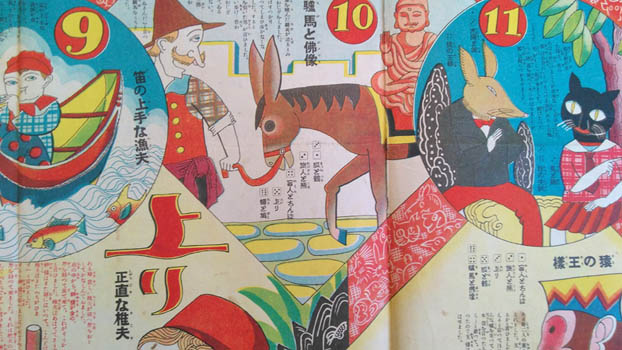

Yoshimoto Sanpei. [Isoppu Sugoroku]. Tokyo, Shogaku 1929 (Showa 4). Colour broadside 54x80cm, folded as issued. A sketch of the cat begun on the back; rumpled and a bit used with a few short marginal tears; not bad. Au$275
This cartoon game of Aesop's fables was the new year gift from the fourth grade magazine in the Shogaku stable. I'd guess the small magazine covers down the left margin are the playing pieces. Yoshimoto was the cartoonist and illustrator for children maybe best known for the ubiquitous bear Korosuke.
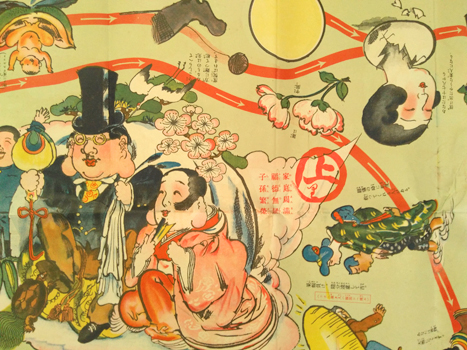
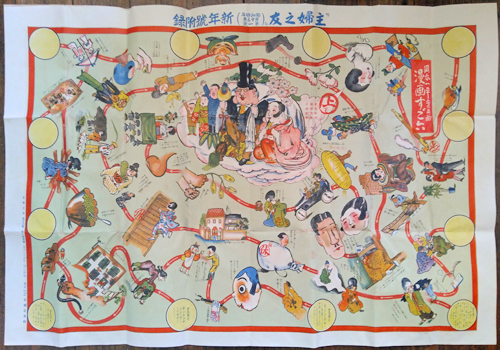
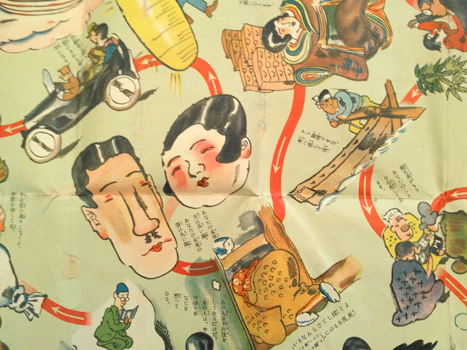
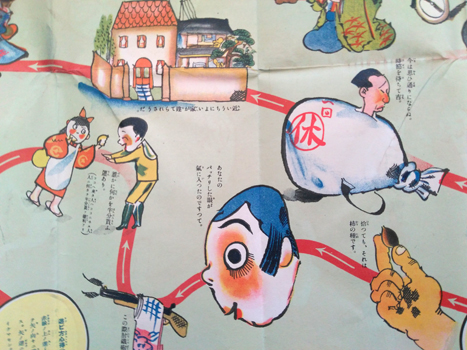

Okamoto Ippei. [Shufunotomo - Manga Sugoroku]. Tokyo, Shufunotomosha 1929 (Showa 4). Broadside 64x94cm; colour printed. Rather good. Au$400
A splendid large and lively sugoroku issued as a New Year gift by the magazine The Housewife's Friend. The game is an intriguing melange, to me, of the modern and traditional; whether in conflict or harmony or all round mocked I don't know. The winning post - the joyful family of plump plutocrats with both husband and wife looking remarkably like lucky gods - is the dream of the modern young woman being hatched from an egg in the upper right but she is not the starting point of the game. There seems to be several starting points. Did any young western woman ever dream of being rich and fat?
Ippei, radical and scallywag, was the king of newspaper cartooning as Rakuten ruled the magazines in Taisho and early Showa Japan. It was Ippei that brought the American comic strip to Japan and he heads, with Rakuten, the lists of idols and inspiration of many modern manga artists.
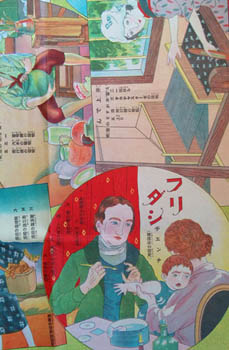
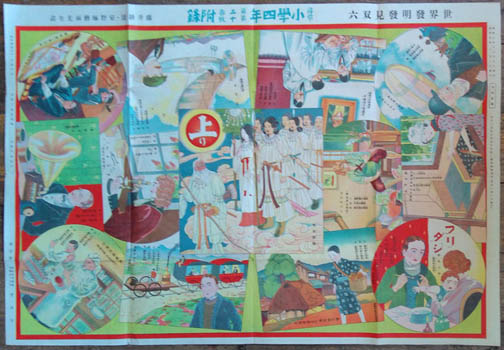
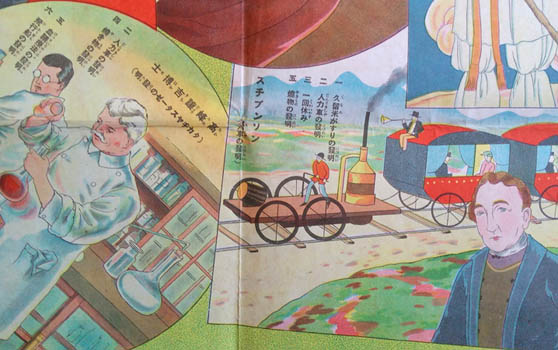
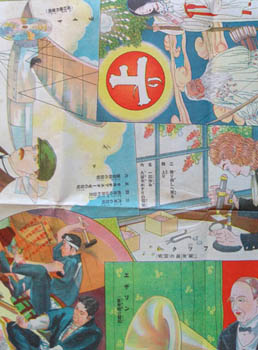

[Sekai Hatsumei Hatsuken Sugoroku]. Tokyo, Shogaku Shinensei Furoku 1929 (Showa 4). Colour broadsheet 54x78cm. A rather good copy. Au$300
An inspirational, if odd, game celebrating great inventors. This was the new year gift from Shogaku Shinensei - a magazine for 4th graders. I'm not sure whether you get to be a god or hang out with a god, join his procession.
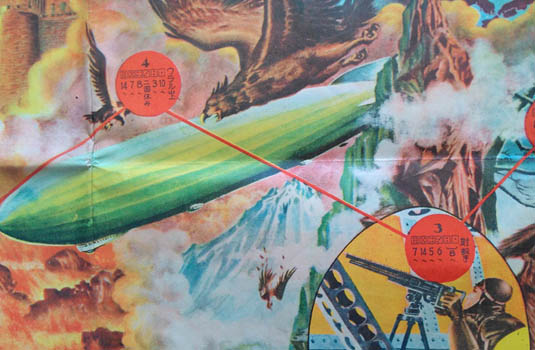
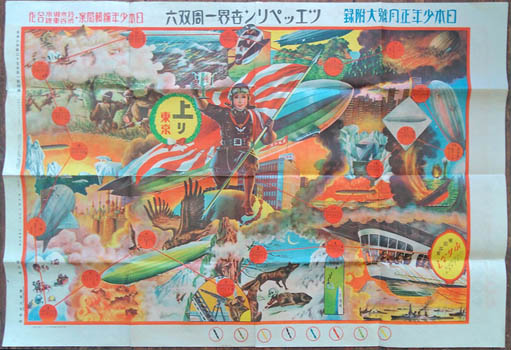
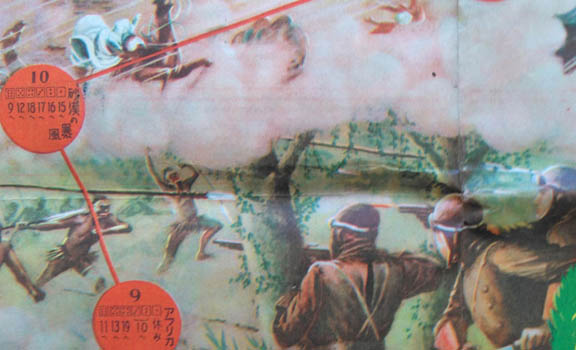
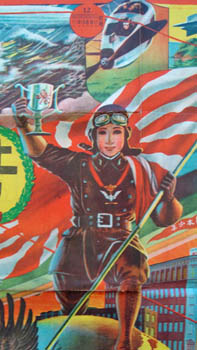

Shibuya Shigeo & Suzuki Gyosui. [Tsuepperin Sekai Isshu Sugoroku]. Tokyo, Nihon Shonen 1930 (Showa 5). Colour broadsheet 54x79cm. Minor signs of use, a little rumpled; a rather good copy with playing pieces - propellors - in the bottom margin. On the back is a duller game about athletics in red, white and blue. Au$500
The new year gift from the boys' magazine Nihon Shonen, this is an heroic, an epic, zeppelin journey around a world that existed somewhere in the minds of writers and illustrators for boys. Every step, every part of nature, every being, is a peril, a hazard to be fought and beaten. Girls win by accepting, boys win by taking a cudgel, or even better a machine gun, to everything in their path.
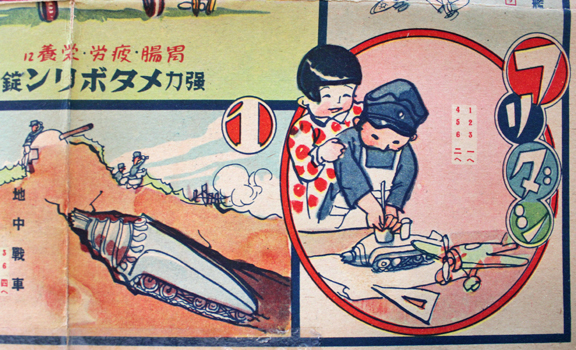
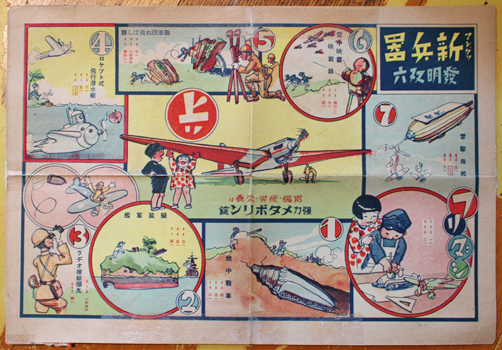
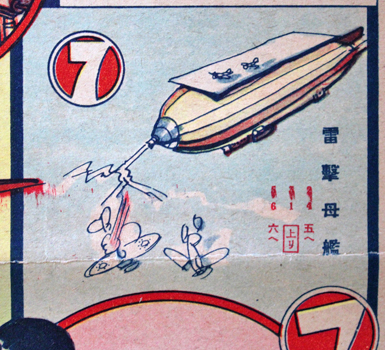
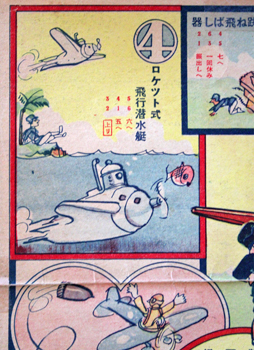

Advertising sugoroku. Metabolin. [Manguwa Shin Heiki Hatsumei Sugoroku]. Osaka, Metabolin [193-?]. Colour game on card 26x39cm with original folds; advertising on the back in red and blue. This came as a sort of envelope, folded twice with a paper seal holding it together, unfolding to show the game on the inside. Several tape repairs. Au$300
Somewhere, sometime, I don't know when, someone decided that books, pictures, games and toys for tiny children should be simple to the point of idiocy, drably educative as socially prescribed, and starved of imagination. Our artist here has followed the simple line for a way but knew that the thing all toddlers are thrilled by is daring new inventions in weaponry.
This was some sort of gift or premium from the makers of Metabolin, a vitamin B1 supplement, nothing to do with the steroid Metabolin. Maybe you got it after swallowing a hundred tablets.
Naturally I can't find mention of another copy anywhere, not even in the Kitatama Pharmaceutical Association Mueum which has several games and paper toys.
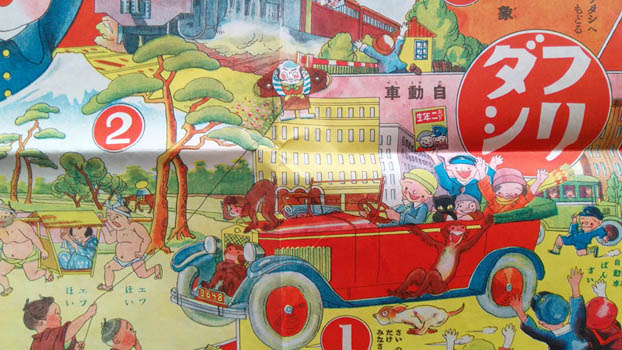
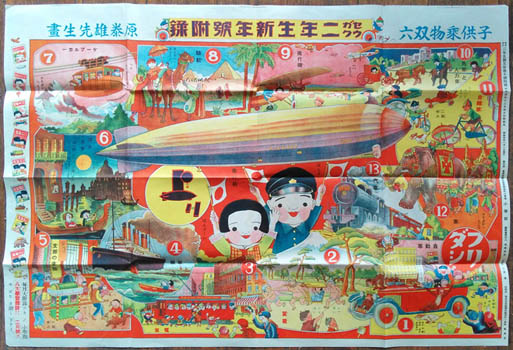
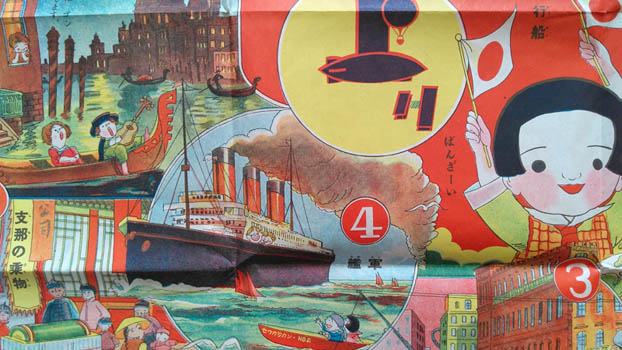
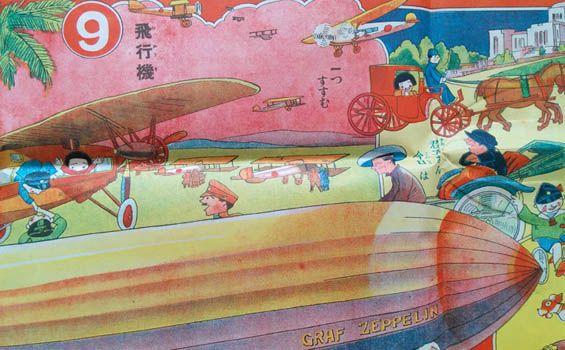

Sugoroku. [Kodomo Norimono Sugoroku]. Tokyo, Seugaku Ninensei 1930 (Showa 5). Colour lithograph broadside, 54x78cm. A rather good copy. Au$500
An exciting and vivid jaunt around the world and all forms of transport is the theme here. This was the New Year treat that came with the magazine Seugaku Sophomore (for the second year of primary school).
I don't know who those two kids are but they never aged and, with updates in fashion and style, seem to have been on a ceaseless whirl of travel and adventure ever after. For decades new but the same sugorokus appeared. The zeppelin vanished of course, square automobiles became sleek cars, trains went diesel and electric, aeroplanes became jets, and on they went. Perhaps they learnt early what many idle wealthy globe trotters know: that a diet of fine demi-sec and pure cocaine keeps you young forever.
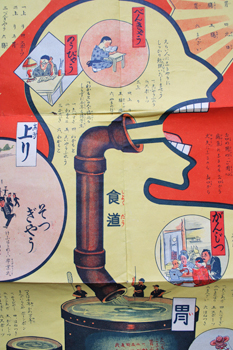
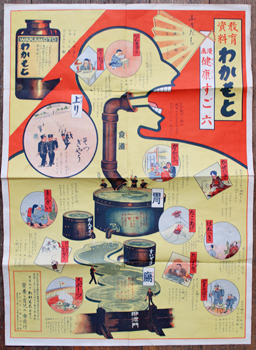
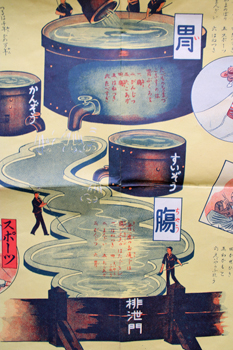
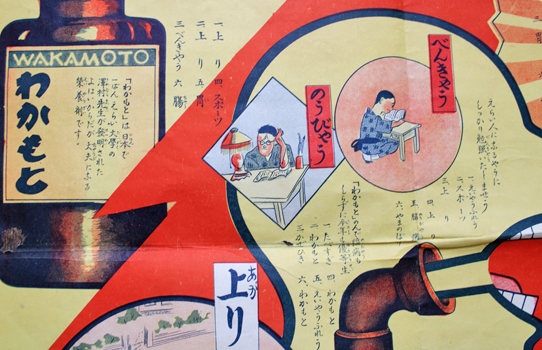

Wakamoto sugoroku. - [Wakamoto - Manga Kenko Sugoroku]. Tokyo, Wakamoto [c1930]. Colour poster 63x46cm. Minor signs of use, a smallish hole in the bottle, upper left. Au$850
An early bit of advertising from the health supplement makers and I don't think they've ever done better. The company started in 1929 in Shiba and opened a new plant in 1932; here the address is Shiba. This is a sugoroku, a racing game, and it's a succinct lesson in economics and industrialisation. The body as a machine had been explored by more than one graphic artist but here is not so much an intermediate step as a rational alternative. A production line may be useful but when labour is cheap why would you spend money on machinery? A decent length of sewage pipe, some vats and a manned treatment pond will do the job.
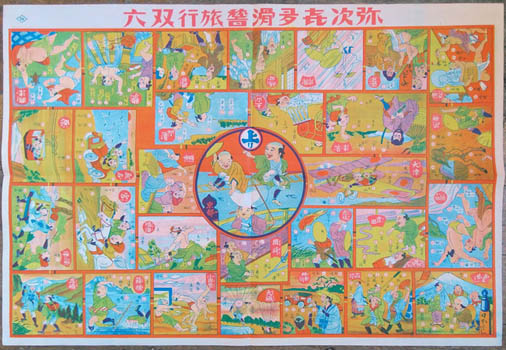
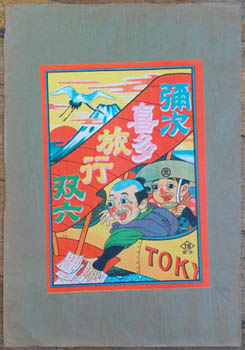
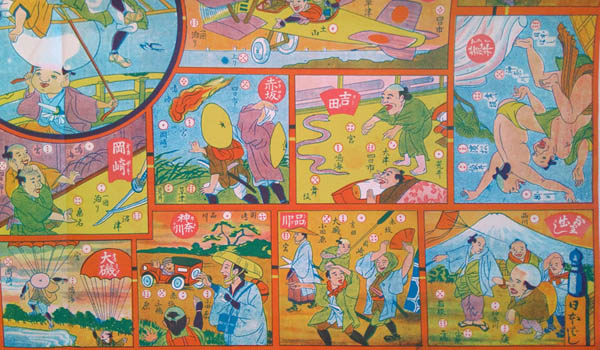
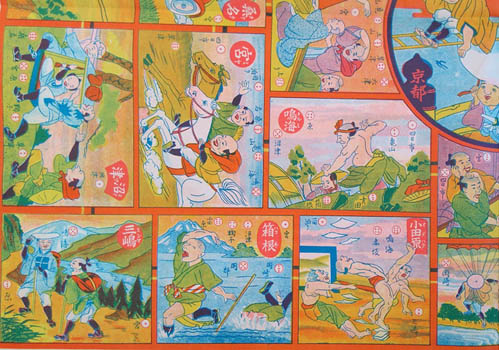

Sugoroku. Nomura Toy Company [Yaji Kita Rokkei Ryoko Sugoroku]. n.p. [c1930?]. Colour broadside 55x79cm; with the large original paper wrapper - 40x28cm - with mounted colour illustration. An excellent copy. Au$500
The comic adventures along the Tokaido of those buffoons Yaji and Kita of Hizakurige - or Shank's Mare - fame, not so much updated as flung though wormholes in time. All is still Edo in period but for the airplane, those motorcars, cable car, parachutes. This is not a sugoroku produced as a new year gift by a newspaper or magazine - the usual form of these games first half of the 20th century. It was made by Nomura Toys, presumably for sale. Hence the extra large, lurid paper wrapper. Nomura Toys started in the early twenties and went into tin toys in a big way after the war.
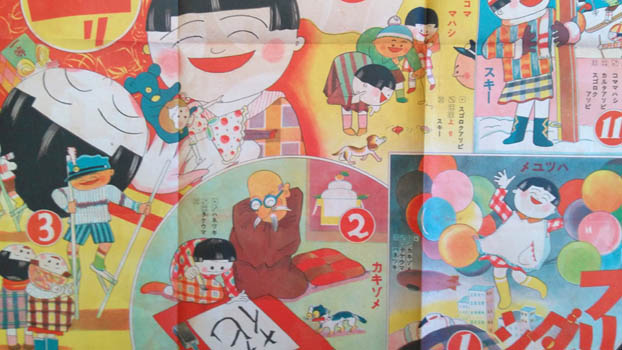
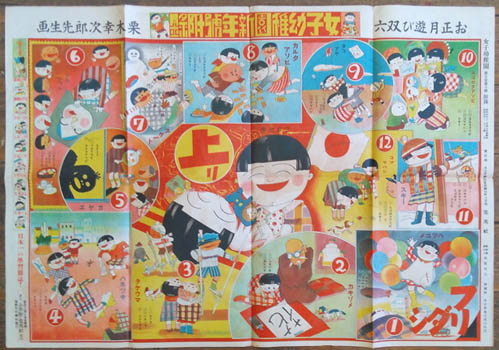
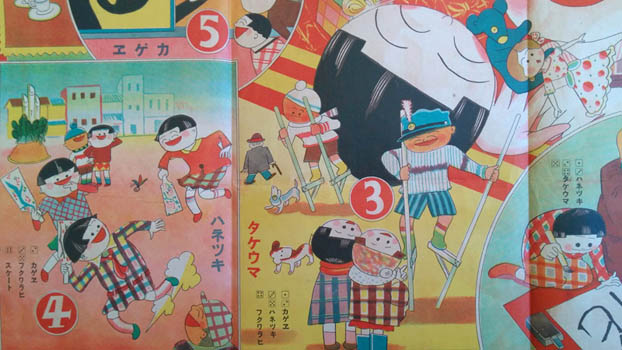
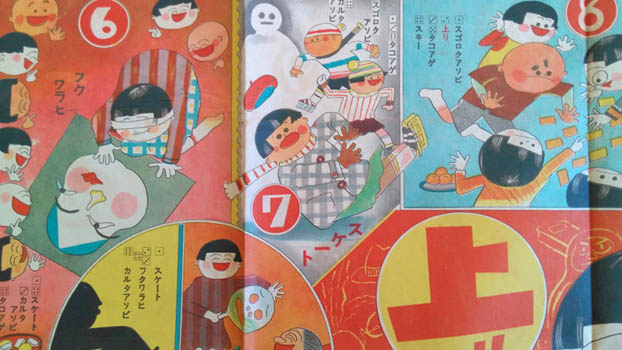

Kuriki Kojiro. [Oshogatsu Asobi Sugoroku]. Tokyo, Shogaku 1930 (Showa 5). Colour broadside 54x78cm. A bit of browning and short tears in the folds; pretty good. Au$550
The new years gift from the girl's kindergarten magazine of the Shogaku stable. A cheerful sugoroku in which a girl gets to have fun - remarkable enough in itself. And yes, there is a zeppelin down in that corner. The small adverts for the various magazines down the left margin are maybe playing pieces.
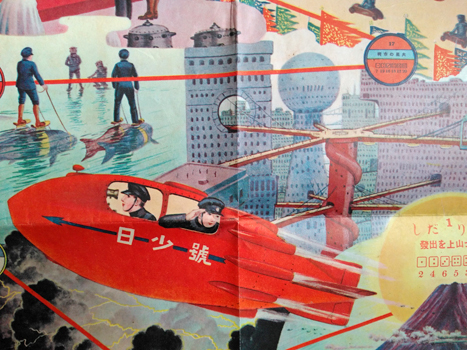
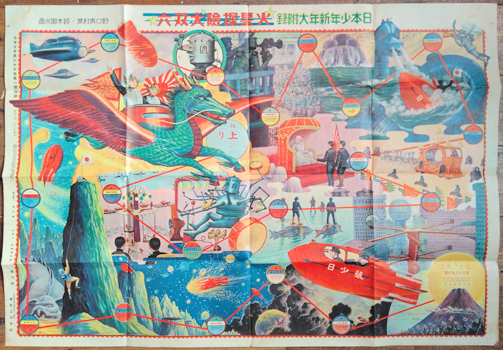
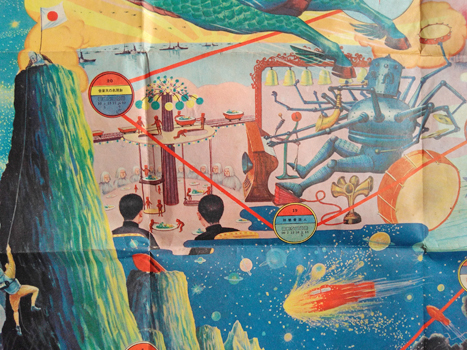
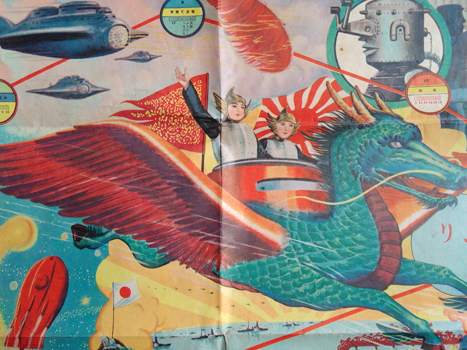

Suzuki Gyosui. [Kasei Tanken Dai Sugoroku]. Tokyo, Nihon Shonen 1931 (Showa 6). Colour broadside 54x78cm. A little browning and a couple of spots; rather good. Au$450
The new year gift from the boys' magazine Nihon Shonen is a splendid, faithful record of these Japanese boys' expedition to Mars. Artist of many parts, Suzuki had accompanied some intrepid boys on a ferocious zeppelin tour of the world the year before this and made a specialty of battle scenes in later years. Before this he produced gentle night scene woodcuts.
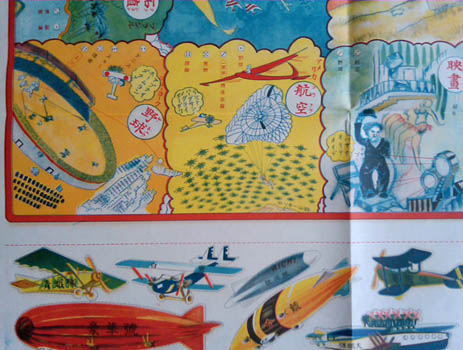

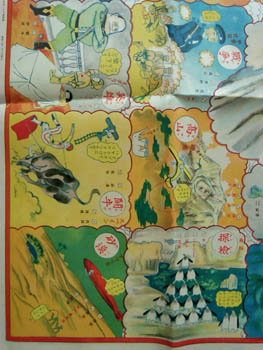
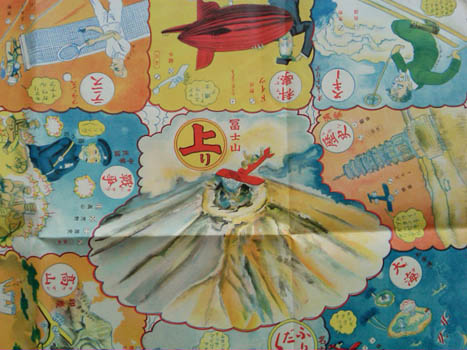

Tsutsumi Kanzo. [Manga sugoroku sekai haya nozoki]. Nagoya(?), Shin Aichi 1931 (Showa 6). Colour lithograph broadside, 55x70cm; Folded, a touch of nibbling on one edge; a nice copy with the playing pieces intact in the right margin. Au$400
Sugoroku, these paper racing games, like most genres of Japanese graphics range from the fabulous, through insipid to kitsch to awful to downright disturbing. This one is up the fabulous end of the scale.
Tsutsumi - one of the great pioneers of modern manga - takes two young aviators on quick world tour and shows them all the most important things. Curious, for me, is that each stop is not headed with the country name but some quality, some spectacle, some activity. Thus meeting Mussolini in Italy is titled 'hero'; for baseball we see see Babe Ruth knocking over a New York skyscraper; tennis is Henri Cochet in France; film is of course Charlie Chaplin in Hollywood; science is a zeppelin in Germany; war is Chiang Kai-shek in China; manners are learnt in England from Ramsay MacDonald; I'm not sure what the gymnastic penguins in the Antarctic represent. And so on round the globe with celebrity and national stereotypes galore.
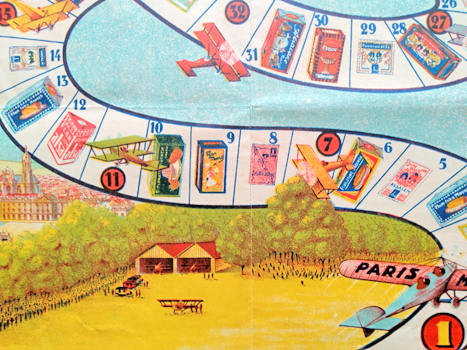
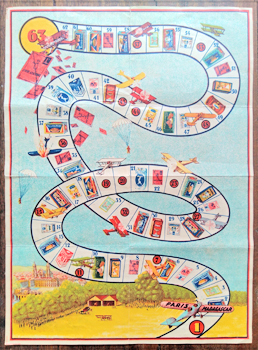
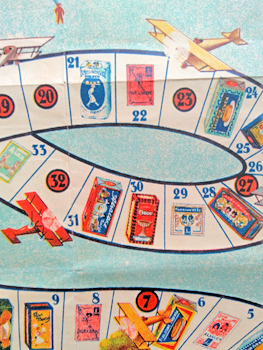
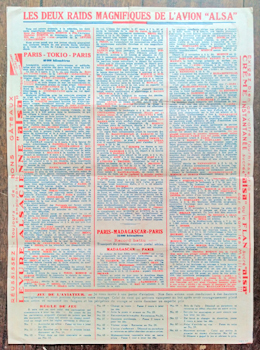

Aviation paper game. Paris - Madagascar [Les Deux Raids Magnifique de l'Avion "Alsa" on the back]. n.p. Alsa [c1931]. Colour lithograph 36x27cm. text on the back in red and blue. Old folds, pretty good. Au$150
Two heroic record breaking flights - Paris-Tokyo and back and Paris-Madagascar and back, both in 1931 - were made to honour Alsa biscuits, cakes and baking powder.
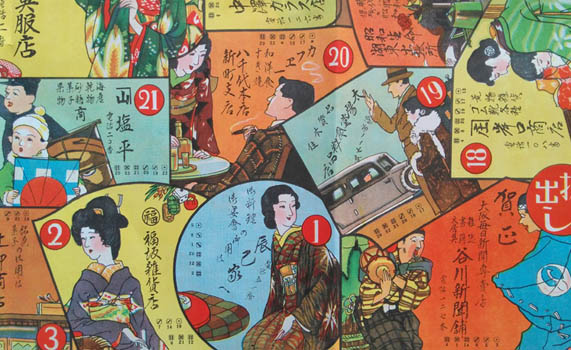
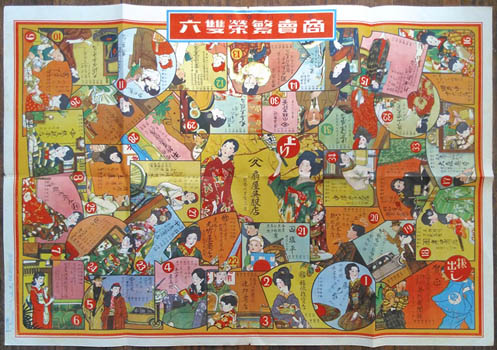
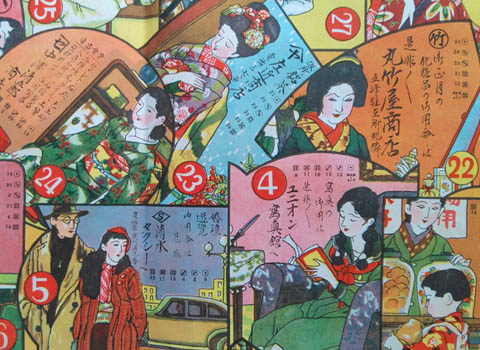
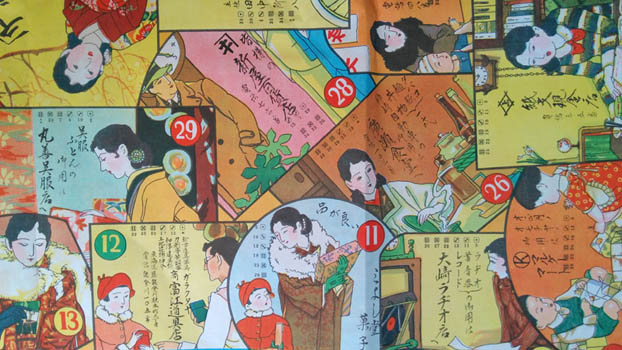

Advertising Sugoroku. [Shobai Hanei Sugoroku]. Tokyo printed, Notagawa Ekimae Shoten 1935 (Showa 10). Colour broadside 79x55cm. Minor signs of use, a pretty good copy. Au$400
A proper aspirational sugoroku for girls and young women. Prosperity is the reward for the perfect modern girl: good husband, handsome family and shopping, shopping shopping. This shopping game advertises the glamorous range of businesses in Notagawa - now part of Higashiomi, more or less half way between Kyoto and Nagoya. The same game, relabelled, was used for businesses of Matsumoto City. A very similar - a few panels the same - but not so modern game - more kimonos, fewer cars, furs and bobbed or marcelled heads - with the same title was issued the year before by the newspaper Tokyo Nichinichi Shinbun for readers in the Iwamurata-machi area. You don't waste a good idea and a decent bit of artwork.
  1 2 [3] 4 1 2 [3] 4   |